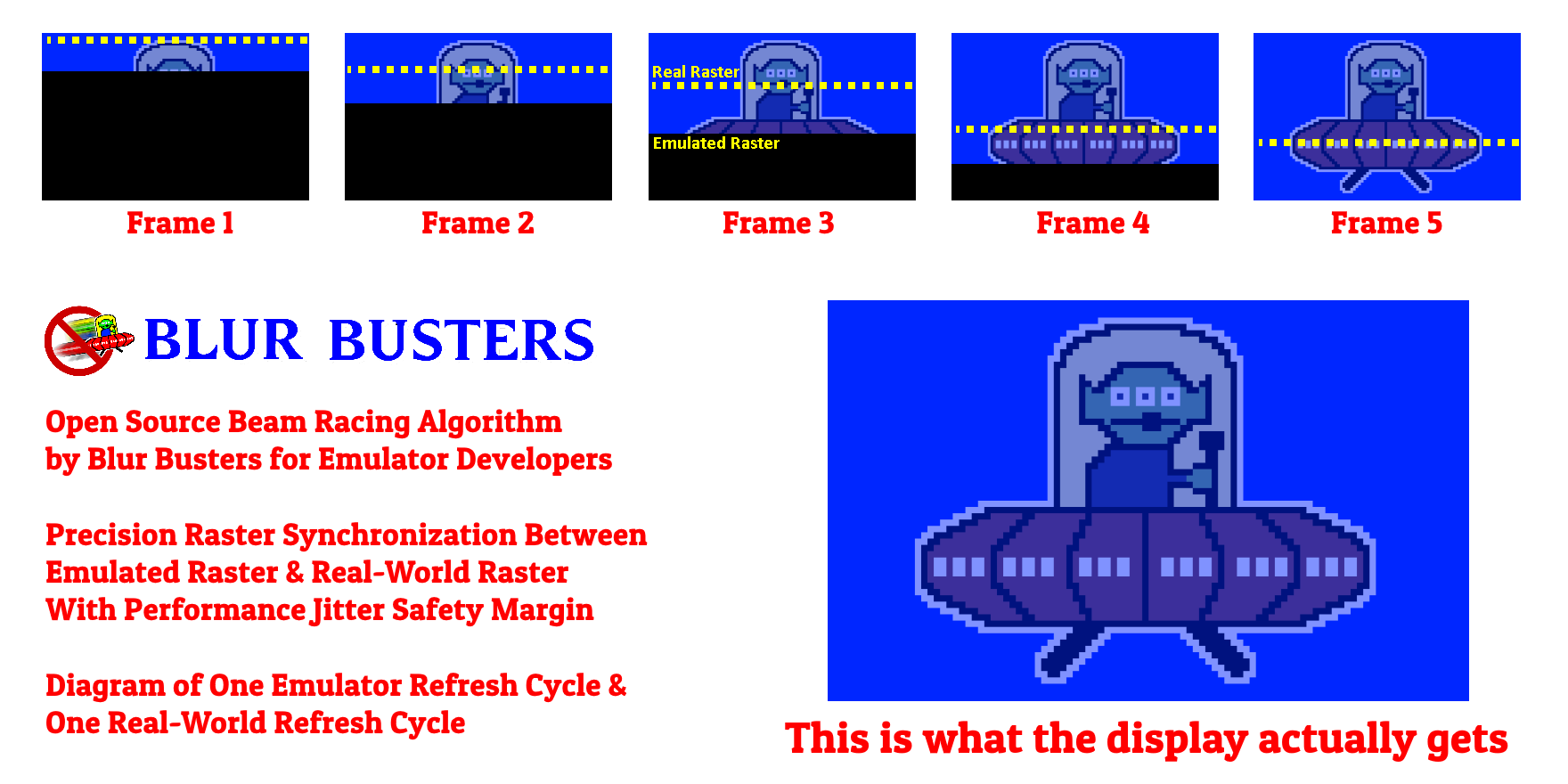Update: Four emulator authors actively chatting in subsequent pages of this thread
SKIP if you aren't a programmer/developer and/or unfamiliar with raster scan line operations. This post is for 8-bit emulators like old consoles and computers, that uses raster-accurate emulation
An algorithm for a tearingless VSYNC OFF that creates a lagless VSYNC ON
An approximate synchronization -- a "beam racing" implementation -- of the emulated raster ahead of the real-world raster, with a forgiving jitter margin (<1ms).
Essentially, a defacto rolling-window scanline buffer achieved via high-buffer-swap-rate VSYNC OFF (redundant buffer swaps) -- with the emulator raster scanning ahead of the realworld raster, with a sufficient padding margin for performance-jittering making scanline-exact unnecessary -- just approximate raster sync (within ~0.1ms to ~0.2ms pratical with C/C++/asm programming).
OPTION1: There are raster-polling functions on some platforms (e.g. RasterStatus.ScanLine as well as D3DKMTGetScanLine ...) to let you know of the real-world raster.
OPTION2: Other platforms may need to extrapolate based on time intervals between VSYNC heartbeats. This can actually be done super-accurately, with good math formulas and VBI-size awareness. Video: https://www.youtube.com/watch?v=OZ7Loh830Ec
This can be used to synchronize to the emulator's raster within a rolling-window margin.
Simplified diagram:

Long Explanation:
https://www.blurbusters.com/blur-buster ... evelopers/
This is a 1/5th frame version, but in reality, frame slices can be as tiny as 1 or 2 scanlines tall - or a few scanlines tall, computer-performance-permitting.
Tests show that I successfully can do roughly 7,000 redundant buffer swaps per second (2 NTSC scanlines) in high level garbage-collected C# programming language of 2560x1440 framebuffers on a GTX 1080 Ti.
With proper programming technique, darn near 1:1 sync of real raster to virtual raster is possible now. But exact sync is unnecessary due to the jitter margin and can be computed (to within ~0.5-1ms margin) from an extrapolation between VSYNC timings if the platform has no raster-scanline register available.
- Only ~10% overhead added to CPU.
- Tearing-less VSYNC OFF: Lagless VSYNC ON
- As long as emulated raster stays ahead of real raster, the black part of frame never appears
(or just use previous frame in place of black, to reduce artifact risk) - Same number of pixels per second.
- Still emulating 1:1 emulated CPU.
- Still emulating the same number of emulator rasters
- Still emulating the same number of emulator frames per second (60 fps).
- Performance can jitter safely in the frame-slice height area, so perfect raster sync not essential.
- Lagless VSYNC ON achieved via ultra-high-buffer-swap-rate VSYNC OFF
- It’s only extra buffer swaps mid-raster (simulating a rolling-window buffer)
But C++ or C or assembler would have no problem, and probably can do it within <0.1ms -- permitting within +/- 1 scanline of NTSC (15.6 KHz scan rate). Input lag will be roughly equivalent to ~2x the chosen jitter margin you choose -- but if your performance is good enough for 1-emulated-scanline sync, that's literally 2/15625 second input lag (less than 0.2ms input lag) -- all successfully achieved with standard Direct3D or OpenGL APIs during VSYNC OFF operation for platforms that gives you access to polling the graphic's card current-raster register. The jitter margin can be automatic-adaptive or in a configuration file.

Can be made compatible with HLSL (but larger jitter margin will essential, e.g. 1ms granlarity rather than 0.1ms granularity) since you're forcing the GPU to continually reprocess HLSL. A performance optimization is that one could modify the HLSL to only process frameslice-by-frameslice worth), but this would be a difficult rearchitecturing, I'd imagine.
Most MAME emulators emulate graphics in a raster-based fashion, and would be compatible with this lagless VSYNC ON workflow, with some minor (eventual, long-term) architectural changes to provide the necessary hooks for mid-frame busywaiting on realworld raster + mid-frame buffer swaps.
To read more about this algorithm and its programming considerations, see https://www.blurbusters.com/blur-buster ... developers

